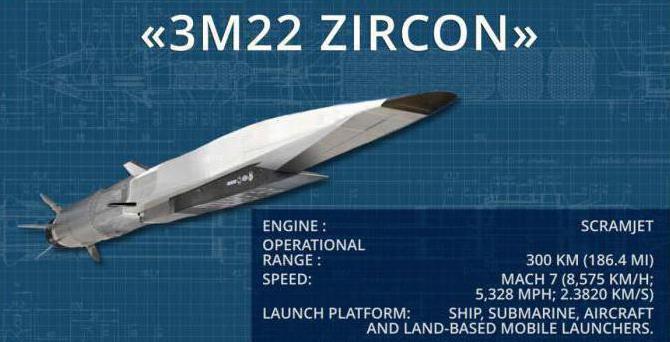On February 20th, Russian President Vladimir Putin officially revealed the Zircon 3M22 hypersonic cruise missile.
The 3M22 Zircon or the SS-N-33 is a maneuvering anti-ship hypersonic cruise missile developed in Russia. Earlier speculation estimated that the Zircon’s range is 500 km at a low level and up to 750 km at a semi-ballistic trajectory, but Putin in his announcement said the range is over 1,000 km.
It’s a two-stage missile that uses solid fuel in the first stage and a scramjet motor in the second stage. This missile will be incorporated into the Kirov-class battlecruiser Admiral Nakhimov this year and the Pyotr Velikiy in 2022. The new Yasen-class submarines will also reportedly be armed with the new hypersonic cruise missile.
“The Zircon missile is strategically valuable due primarily to its speed. In April 2017, it was reported that the Zircon had reached a speed of Mach 8 during a test. If that information is accurate, the Zircon missile would be the fastest in the world, making it nearly impossible to defend against due to its speed alone. Another valuable aspect of the missile is its plasma cloud. During flight, the missile is completely covered by a plasma cloud that absorbs any rays of radio frequencies and makes the missile invisible to radars. This allows the missile to remain undetected on its way to the target.”
According to Putin’s announcement the missile can be launched from land-, ship- and submarine-based systems, and can travel with up Mach 9 in the dense layers of the atmosphere. No air defense or missile defense system can deal with that speed.
It has been in development since 2011 and passed its most recent tests, reaching a speed of Mach 8 on December 10th, 2018, according to a CNBC report.
“What we are seeing with this particular weapon is that the Russians designed it to have a dual-purpose capability, meaning, it can be used against a target on land as well as a vessel at sea. Last week’s successful test showed that the Russians were able to achieve sustained flight, a feat that is crucial in the development of hypersonic weapons,” an anonymous CNBC source said back then.
There are also videos showing talking about the missile in April 2017.
The Russian Ministry of Defense’s ZvezdaTV also interviewed Russian retired Rear Admiral Vsevolod Khmyrov. He commented on the possibility of the US placing missile systems in Europe after the withdrawal from the INF Treaty is finalized.
The US has already deployed unified Mk41 launchers in Romania, similar systems are being deployed in Poland. These installations are also capable of launching Tomahawk cruise missiles.
“Taking into account the fact that American missile systems are, it is clear that they will also be managed from decision centers located in the Americas,” Khmyrov stressed.
According to the rear admiral, the US believes that it can protect itself by placing its launch and information assets near the Russian borders, on the territory of its NATO allies.
“The Americans are hoping that, due to their remoteness from Russian territory, in the event of a response from the Armed Forces of the Russian Federation, these centers will remain inaccessible to Russian high-precision long-range weapons,” he said.
However, the Zircon may become a threat not only for the medium-range missiles that could possibly be deployed in Europe, but also can ensure the defeat of key elements of the control system – the decision-making centers located outside Europe.
“Based on the data that was voiced by the president in his announcement, it is not difficult to carry out operational calculations. If the carrier with the Zirkon missiles is located at a distance of 500 kilometers from the coastline, then it will be possible to reach targets in the coastal strip at a distance of at least 500 kilometers in five minutes. What can be done during this time? At best, the missiles flying towards the target may be detected, but they can’t be intercepted. Such a hypersonic system as Zircon penetrates practically any air defense and missile defense system. There is no protection from it,” Khmyrov concluded.
According to him, considering that the number of surface ships and submarines, armed with Zircon hypersonic cruise missiles, present in the Western Atlantic and Eastern Pacific Ocean can be two or three ships in each region, with each vessel having about 40 missiles on board. Such a number of hypersonic cruise missiles would almost certainly guarantee that the US military control centers are destroyed, according to the retired Admiral.
MORE ON THE TOPIC:
- MiG-31s Armed Kinzhal Hypersonic Missiles Conducted Over 380 Patrols, Carried Out Multiple Live Fire Drills
- First Ever Video Of Nuclear-Capable Poseidon Underwater Drone Released Online
- Putin’s Federal Assembly Adress: Sea-Launched Hypersonic Missile And News On Other Modern Weapons
- Russian Nuclear Submarines: Weapons Of Global War
- Russia’s Stealthy Strike UAV. Deadlier Than Expected
- INF Is Dead. Europe Is One Step Closer To Nuclear War
- Restoring Strategic Balance: Russia’s ‘Invincible’ Nuclear Weapons






